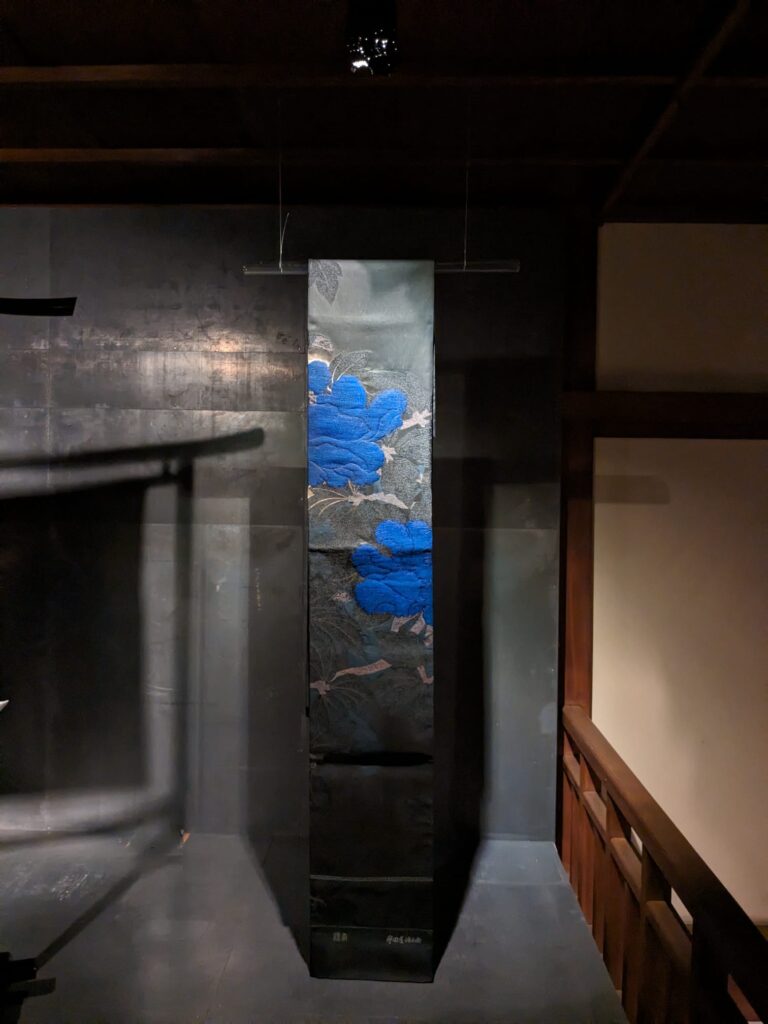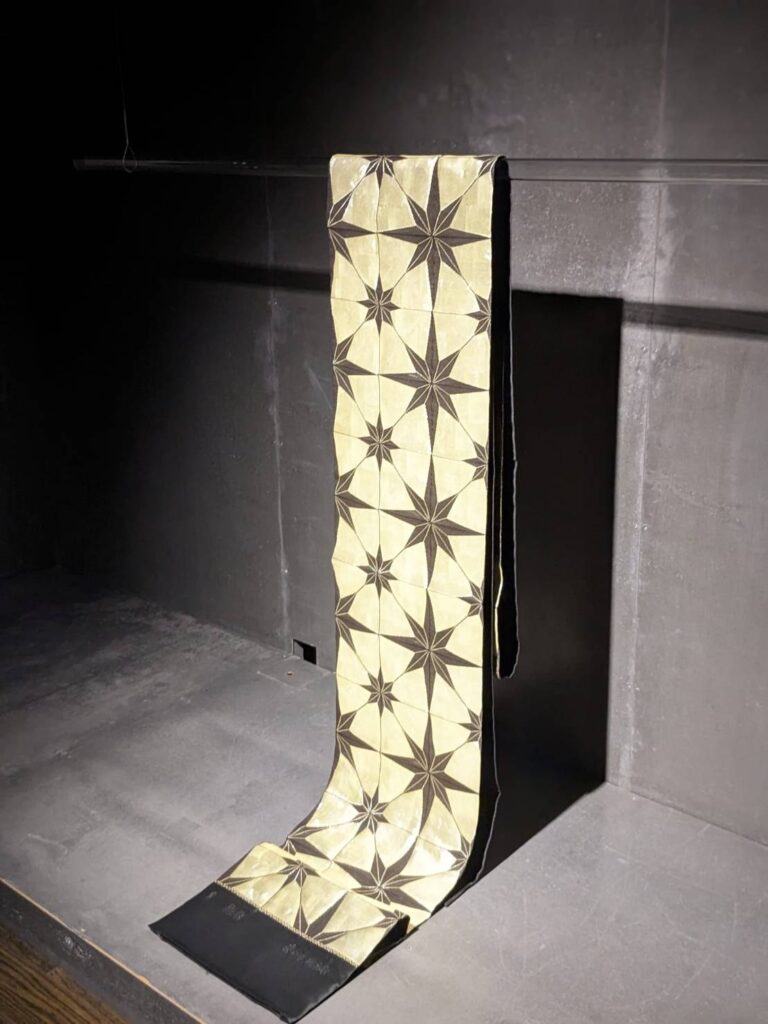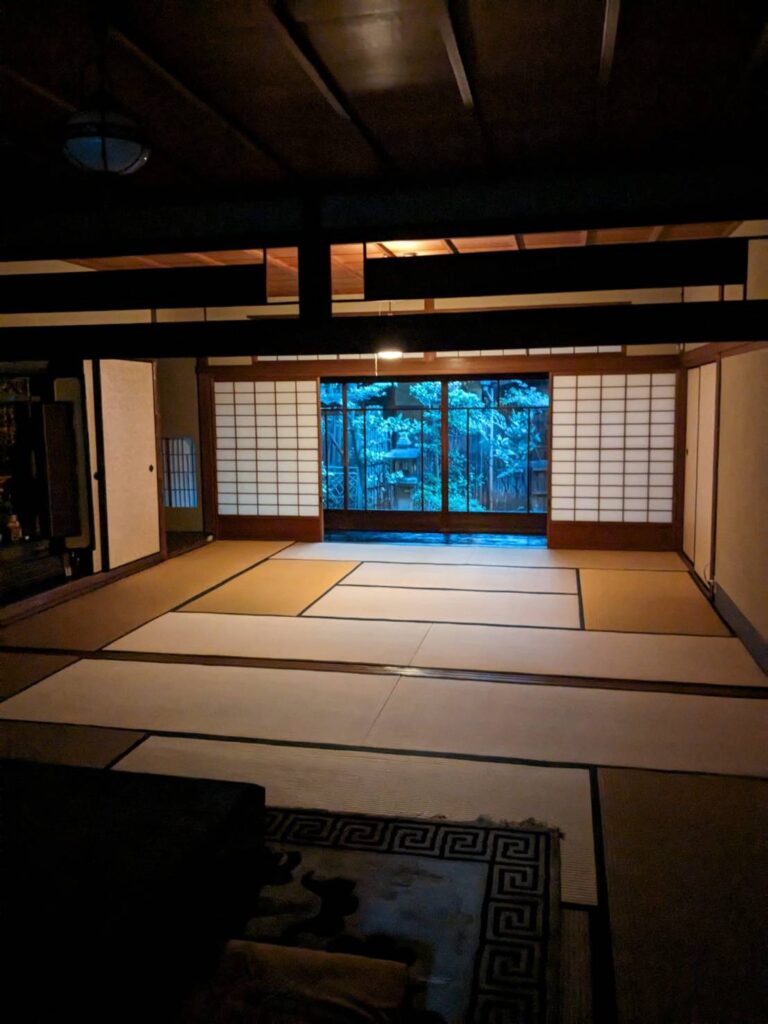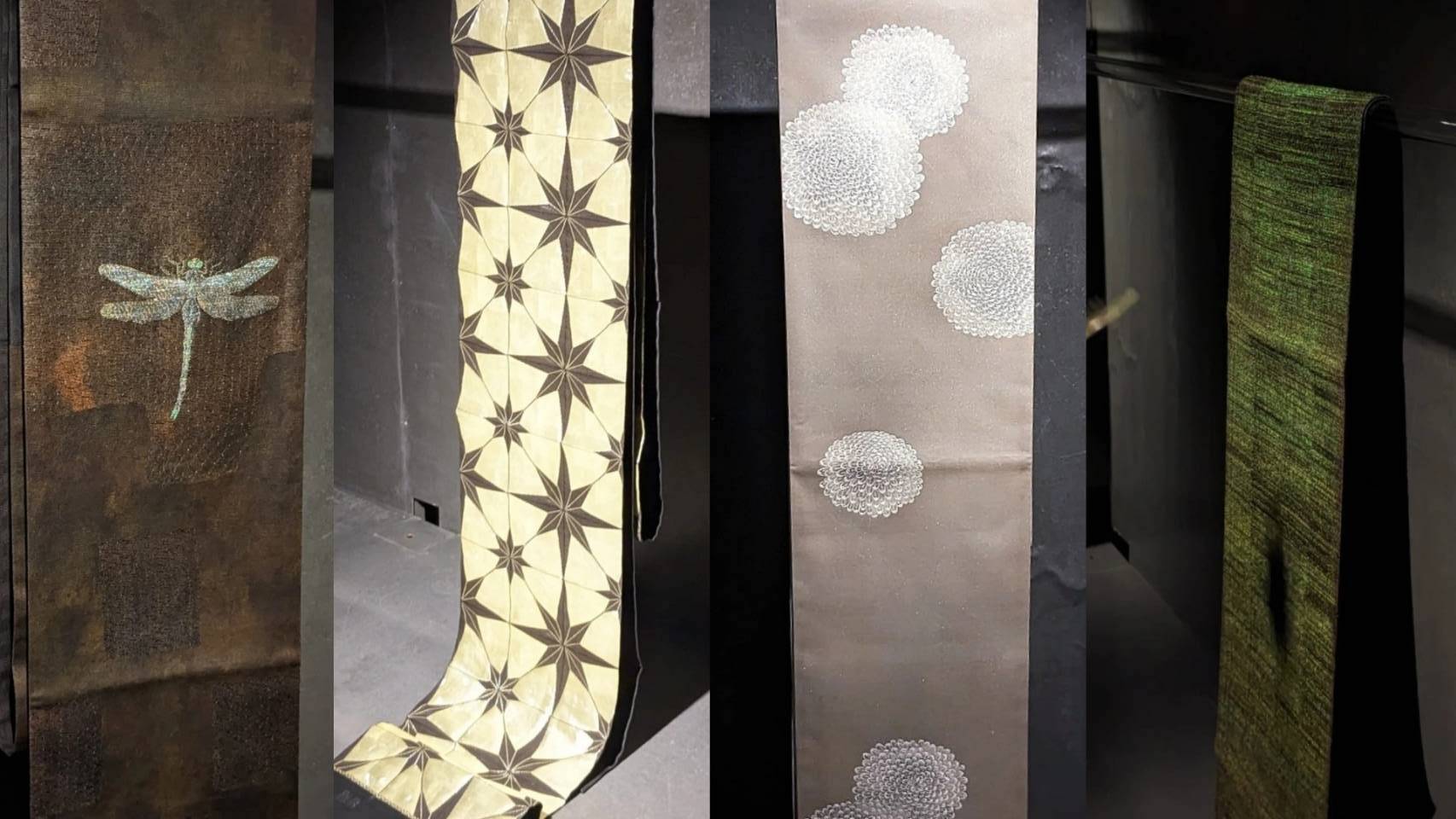Please scroll to the bottom of the page for the English version.
12月中旬にこちらのブログで発信した、創業285年「誉田屋源兵衛」十代目山口源兵衛さんへのインタビュー第一弾に引き続き、第二弾を執筆していきます。
源兵衛さんは国内外に熱狂的信奉者がいらっしゃり、代々受け継がれてきた技術と伝統を引き継ぎつつ、着物業界に「革新」を起こすような作品を次々と発表されています。帯業界の異端児とも呼ばれているとか。
「誉田屋源兵衛」オフィシャルウェブサイトはこちら。 https://kondayagenbei.jp
第一弾でもお話しましたが、私が源兵衛さんのことを知ったのは、パートナージョセフが源兵衛さんの帯の動画をYoutubeで見つけたのがきっかけ。その動画で紹介されていた漆黒の生地にラピスラズリを使用して大胆に牡丹が織り込まれた帯を見た瞬間に虜に。11月の帰国時に様々な奇跡が重なり、なんと京都で源兵衛さんに直接お会いしてインタビューをさせていただく機会に恵まれました。

前回は、源兵衛さんからお聞きした「教科書には載っていない日本の歴史」「物事を複雑化しすぎる現代人」「観光地ではない本当の京都と日本の文化」について執筆しました。
(第一弾はこちらからご覧いただけます。→https://ayakanoikigaidou.com/post-5026/)
今回の第二弾では、「源兵衛さん自身のお寺での修行のお話」「親友 田中泯さんとの出会い」「源兵衛さんの意外なご趣味」など、源兵衛さんのプライベートにもう一歩踏み込んだお話をご紹介していきます。
- 当時50歳だった源兵衛さんのお寺での修行のお話
- 時間は命
- 親友 田中 泯さんとの出会いと源兵衛さんが感じる最高の瞬間
- 「染め」の本来の意味と古代のシンプルな考え方
- 源兵衛さんの意外な趣味「ハブ獲り」
- 源兵衛さんが参加する命がけの祭り
- 鹿狩りのお話と動物を食すということ
- 第三弾は「誉田屋源兵衛」で実際に見せていただいた今まで見たこともないような素晴らしい帯の詳細を公開!
- Interview with Mr. Yamaguchi Genbei, 10th Generation of the Esteemed 285-Year-Old Obi Manufacturing and Sales Company, Kondaya Genbei, in Kyoto Part 2
- At the age of 50, Mr. Genbei engaged in ascetic training at the temple
- Time is Life
- Meeting with Best Friend, Mr. Tanaka Min, and the Pinnacle Moments According to Genbei
- The Original Meaning of “Dye” and Ancient Simple Perspectives
- Genbei’s Surprising Hobby: Snake (Habu) Hunting
- Genbei’s Participation in a Life-Threatening Festival
- Talking about Deer Hunting and Consuming Animals
- The third installment will reveal detailed information about the stunning obi that I had the privilege to see at “Hodataya Genbei.” These obi are unlike anything I have seen before.
当時50歳だった源兵衛さんのお寺での修行のお話
源兵衛さん:僕は50歳の時に、今までの自分がつまらんと思って、50歳からもっとマシな人間になろうと思って、けじめ付けようと修行をした。その時は飲まず食わずを1週間やったよ。水も飲まへん。
全然大丈夫。人間はもっとできると思った。まだいけると思ったもん。なんもしんどないよ。二日間くらい口がネバネバする。でもお腹がすくのも忘れて、ネバネバも消えていく。
私:そのお話をお聞きすると、私めちゃくちゃ自分の体甘やかしてます。
源兵衛さん:修行を重ねると小さな一つのたらいで、順序間違えなかったら、頭から爪先、そして歯磨きまでその水だけで全て済ませることできるんよ。あと本格的なお坊さんがすっと座禅を組むのを見るとびっくりする。座った瞬間に石になるよ。本当に美しい、それがざっと並んだら本当に凄い。
時間は命
興味深いお寺での修行のお話から、源兵衛さんが50歳のタイミングで自分をつまらないと思われた理由にさらに興味が湧き、深くお聞きしました。
思わず私が発した第一声は、
私:えっ?何で?絶対つまらなくないですよね?!!
源兵衛さん:いや、やっぱり時間は命やん。それをどう過ごしてきたかと考えた時に情けないなと思うわけよ。
私:えっ?!!!でも周りからは称賛されているはずですよね?そして現状75歳になられて、50歳の時のご自身と比べて、満足できていますか?
源兵衛さん:いや、もう一切できへん。作ったもんも嫌やし。そんなもんよ。そうじゃなかったら前行かへんやん。
私:分かります。それが向上心につながるわけですもんね。源兵衛さんと自分を一緒にするには大変おこがましいのですが、私もバンクーバーでどれだけやっても満足出来ないし、大好きな日本と家族から離れて、仕事も辞めてまで来たこのバンクーバーでの貴重な時間を無駄していないかどうか、毎日自問自答しています。
親友 田中 泯さんとの出会いと源兵衛さんが感じる最高の瞬間
そしてお話は親友のダンサー田中泯さんとの出会いに。
こちらは田中泯さんについてのドキュメンタリーの予告動画。もしご存知ない方がいらっしゃいましたら是非こちらの動画をご覧ください。
源兵衛さん:まず泯さんとは30年前くらい前に会うたんよ。そして2,3年して田中泯の本をたまたま本屋で見て「僕の衣装は裸だ」と書いてあってムカっときた。衣ほど恐ろしいもんはないでと。衣をなめるな。衣がどれほどの影響を与えるか分かっとらん。そして衣装をばっと送りつけた。
そこから彼の衣装をずっと作っている。
たまに泯さんが「源兵衛さんの衣装踊りにくいわ」というけど、俺は踊りやすいために作ってない。戦いなんや。俺が一番嬉しいのは、泯さんが俺の衣装を見た時に最初は否定する。否定して、肯定に転じた時が最高なんや。最初から褒められたらおもろない。戦いの末に馴染んでほしいわけ。
源兵衛さん:この衣装は、泯さんが「源兵衛さん、二条城の松になりたい。」とかアホなこと言うから。笑
おう、分かったと。そうか。と返事して。
泯は農業を本気でやっているから。「7月から9月真っ黒になって自分は松の木になる。松の葉を羽織りたい」と。それでこれを作って二条城で彼が踊った。
私:このお着物を見せた時なんておっしゃったんですか?
源兵衛さん:これはえらい気に入って。いきなり、気に入ってしもうて。
泯とは物凄い仲ええね。それから色んな衣装を泯に作っている。かなり過激な衣装やで。
私:過激というのは、昔からの概念を崩すような?
源兵衛さん:いや、実は歴史的には僕の方が正しい。みんなが今の昭和の着物を着物やと思っている。そんなもん全然違う。
私:その源兵衛さんがおっしゃる斬新さや型破りというのは常に歴史と繋がっているのですか?
源兵衛さん:うん、繋がっている。でもそれが気分悪いのもあんねん。なんかなんもないとこから生み出したいっていう気持ちもある。
一回泯の下水で染めたよ。それも最高の生地を。文化にあぐらかいているような連中を馬鹿にしたろうと。でも一ヶ月後確認したら、ただの汚いものだった。そんで染め工場の社長にいうて、そこの下水につけた。
そしたらあまりにも美しいんよ。毎日色んな色が流れてくるから。良すぎるんよ。そんで俺が社長に怒ったら、社長も怒っとった。笑 俺は言われる通りにしただけよって!
「染め」の本来の意味と古代のシンプルな考え方
そして話題は「染め」の本来の意味と原料の移り変わりについて。このお話を聞いて「染め=色付け」という私の概念が崩れ去りました。
染めの材料の移り変わりは「血→鉱物→植物」
源兵衛さん:血染めが初源なんよ。みんな知らへん。頭をシンプルにしていかな辿りつかへん。
生贄は血を飲んだやろ。動物は相手の内臓をまず食うやん。塩分やん。塩がとれへんところはそれで生きていった。そやから塩の道と血の道は一緒。血染めした衣を着るとね、獣が寄ってくるんよ。それを敢えて着るのがリーダーよ。
古代の人は大地のエネルギーが欲しかった。その当時は鉱物染めはあんまり色つかへん。色を求めたんではないんよ。今は染めるいうたら色が欲しい思い込んでるんよ。
エネルギーや霊力が欲しかった。今の人間はエネルギーや霊力を信じてないから、目に見えないもの信じてないから。当時の人は目に見えないものこそ大事だった。大地のエネルギーを着て、1日でも1時間でも長く生きるということなんよ。
最初は誰も色なんて考えてないんよ。だからまず大地のエネルギーをいただくという、もっとシンプルな考え方が血やんか。もっとストレート。みんな残酷やいうけれど。昔は残酷ではないんよ。それは生きるための必需なんよ。
動物はシンプルに生きるか死ぬかを考えてるわけやん。それが人間の最初やんけ。
今はあまりにも僅か2%の脳でみんな支配されている。
私:本当そう!自分でも思います!!!
源兵衛さん:あとの残り98%がどんなに賢いか。田中泯は約80歳で1時間半も踊る。彼は頭じゃない。体の賢さをもう確認しているやん。いかに体が自然に戻るか。体や皮膚の賢さ。脳よりもっと賢い。
籠目とか蛇の目という言葉があるやん。向こうに目がいっぱいある。それが大事なものを守る。
今の人は「私」やから。「私」いうのは脳や。自分が見ているとしか思うてへん。
源兵衛さんの意外な趣味「ハブ獲り」
源兵衛さん:僕はそれを体験したいから、実は毒蛇(ハブ)獲りするんよ。体長2mあるで。趣味なんよ。
明日から行くんよ。奄美大島。
私:えっ!趣味について聞きたかったんです!とったハブは最終的にどうするんですか?
源兵衛さん:獲って、食べる。首は落とすよ。スープにする。
私:何をきっかけにハブ獲りを始めたんですか?
源兵衛さん:結局今を信じてただ生きてたらだめやん。辿り着けへんわけや。今を生きてたらそんなこと感じんようになるやん。
それでわかった。ハブが先に僕を見つけたら、僕が先にやられる。先に僕がハブを見つけないかん。ということは向こうの目。それが野生なんや。そやから籠目、蛇目ということはそう言うことやなと言うことに辿り着けるわけや。
島に行ったらやることあらへん。真っ暗やろ。暇やん。35年前から奄美大島に行っている。初めは泥染めのために行っていた。
源兵衛さんが巨大ハブを撮った時の写真を見せてくださいました。そこに写っている源兵衛さんは何故か服を着ておらず。ジョセフが思わず質問しました。
ジョセフ:なんで服を着てないんですか?
源兵衛さん:ははは!!!記念写真で脱いだんよ。それとハブ獲り棒を持っているわけ。これハンディキャップや。相手は命がけや。そしたら俺は素っ裸でおらないかんわけや。あんまりハンディつけたらやらしいやん。あんまり自分が安全圏にいるゆうことはやらしいなと思って。
私:すごく律儀ですね。ハブに対しても!
源兵衛さん:そりゃ相手命がけやもん。それとねハブがね、きっと牙を剥いて毒垂らして、あの獣の顔はすごいよ。
源兵衛さんが参加する命がけの祭り
源兵衛さん:あと実は僕は18年間、危険な祭りに参加してるんよ。日本に人が死ぬ祭りが16個あんねん。毎年死者が出る。
昔はそういうことで神様を喜ばした。神様に死ぬほどの祭りを盛り上げて喜ばそうとしているわけ。それがどんどんなくなって16個。今は大分警察やらの規制がかかっている。
僕は規制のかかっている祭りは行かへん。だからルール変えるところは行かへん。意味がなくなる。
こちらの動画を源兵衛さんに見せていただきました。
私:あっ源兵衛さん!いた!!!ここから落ちて、人が死ぬわけですか?
源兵衛さん:そう、動いている時に飛ぶもんだから。すごいスピードよ。4日間で120kmくらい走る。今年の9月も走ってきたよ。
私:でも、気をつけてくださいね。笑
源兵衛さん:いやいや気をつけるとかいう感覚なら最初から行かへんやん。笑 あまりにも無事安全安心の中に人間がずっといるいうことの方が僕は怖いんよ。
鹿狩りのお話と動物を食すということ
鹿狩りもされるということでその相棒とのこちらの写真も見せてくださいました。(インスタグラムの2枚目)
源兵衛さん:これが鹿狩りの相棒や。この人と鹿狩りも行くよ。
私:源兵衛さん、いい笑顔されてますね!
ジョセフ:どういう方法で狩りますか?
源兵衛さん:ライフルも使うし、罠も仕掛けるよ。この人は鹿狩りのプロやから。彼の夢は熊と戦って、死ぬいうことや。熊と戦って勝つか負けるか。でも本人自信あんねん。
ジョセフ:カナダではブラックベアー、ブラウンベアーは戦えますよ。でもホッキョクグマとハイイログマに出会ったら、死んだ振りをした方がいい。勝てないと思う。カナダに来たら試せるから是非来てくださいと鹿狩りの相棒に伝えてください!
カナダでは狩りが日本よりも日常的で、僕も幼少期は森の中で育って狩りをしました。ライフルも使ったけど、平等じゃないから敢えて弓を使ったりして、挑戦的な状況を作りました。
源兵衛さん:命がけの古代の人にとっては相手の目の方が大事だった。どっちが先に見るかやん。相手の目が怖かったわけ。そっから蛇目や籠目という言葉が生まれた。今はこっち主体で物考えるから。
僕は絶えず初元的な我々の本当の中にまだまだあるもんを湧き上がらせたいわけよ。それが祭りに出たり、ハブを獲ったりする。そっから古代の人の思考に辿りつく。その命がけの時代しか信じられない。そういう時代の人って嘘がないから。
獲って食べるということが一番失礼やないことや。
ジョセフ:分かります。僕の母は魚しか食べれない。なぜなら彼女は魚しか殺せないし調理ができないから。自分が殺せないもの最後まで責任が取れないから。
第三弾は「誉田屋源兵衛」で実際に見せていただいた今まで見たこともないような素晴らしい帯の詳細を公開!
今回の第二弾では源兵衛さんのプライベートに一歩踏み込んだ内容をご紹介させていただきました。
それらの背景から、なぜ人々が源兵衛さんの作る帯を一度見たら忘れられないのか。心を動かされるのか。その理由の一つが明確になりました。
源兵衛さんは人間の生物としての可能性や根源を追求しているから。そしてそれが現代の私たちにとったら斬新に思えるけど、実は本来、私たちの体と本能に刻み込まれているものだから。それを源兵衛さんは帯で表現し、私たちの人間の本能を湧き上がらしてくださるわけです!
そして第三弾では、実際に見せていただいた「誉田屋源兵衛」で保管されている貴重な数々の帯について詳しくご紹介していきます!こちらの帯はその一部。シェル(貝殻)を使用して織られた帯です。(詳細は第三弾で!)


この記事を読んでいただいた日本人の方が日本の文化に誇りを持ち、深く理解するきっかけになりますように。そして自国を愛する心がさらに芽生えますように。
海外の方が、日本の文化に興味を持ち、真の魅力と奥深さの虜になるきっかけになりますように。
そしてそれが、失いつつある日本の美しい文化を守る小さな力添えに繋がりますように。

こちらの写真は「誉田屋源兵衛」の奥に潜むお客様をおもてなしする美しいお部屋です。
第三弾も近日中に執筆しますので、是非ご一読ください!
Interview with Mr. Yamaguchi Genbei, 10th Generation of the Esteemed 285-Year-Old Obi Manufacturing and Sales Company, Kondaya Genbei, in Kyoto Part 2
Following the first installment interview with Mr. Yamaguchi Genbei, the tenth-generation artisan belt maker at “Kondaya Genbei,” which was shared on this blog in mid-December, we will continue with the second installment.
Mr. Genbei has enthusiastic followers both domestically and internationally, and he continues to announce works that not only inherit passed-down techniques and traditions but also bring about “innovation” in the kimono industry. He is even referred to as a maverick in the obi industry.
You can find the official website of “Kondaya Genbei” here: https://kondayagenbei.jp
As mentioned in the first installment, I came to know about Genbei-san when my partner Joseph discovered videos of Genbei-san’s obi on YouTube. The moment I saw the bold peony woven into jet-black fabric with lapis lazuli, as featured in one of those videos, I was captivated. Miraculously, during my return to Japan in November, various events unfolded, leading to the opportunity to meet Genbei-san in Kyoto and conduct an interview.
In the first installment, we delved into topics such as “Japanese history not found in textbooks,” “the modern tendency to overly complicate things,” and “the authentic Kyoto and Japanese culture beyond tourist attractions,” as shared by Mr. Genbei.
(You can read the first installment here: → https://ayakanoikigaidou.com/post-5026/)
In this second installment, we will further explore Mr. Genbei’s personal stories, including his experiences in practicing at his own temple, his encounter with his close friend Mr. Tanaka Min, and surprising aspects of Mr. Genbei’s personal interests. Please stay tuned for more insights into Mr. Genbei’s private life.
At the age of 50, Mr. Genbei engaged in ascetic training at the temple
Genbei: When I turned 50, I felt dissatisfied with who I was until then and thought, “I should become a better person from the age of 50 onwards.”
I decided to draw a line and undergo training. At that time, I went without food or drink for a week, not even drinking water.It was completely fine. I thought humans could do more. I still felt I could go on. It wasn’t difficult at all. My mouth got a bit sticky for about two days. But I forgot about feeling hungry, and the stickiness disappeared.
Me: Hearing your story, I realize I pamper my body a lot. (laughs)
Genbei: Through continuous training, you can use a small basin. If you follow the right order, you can do everything from washing your face to brushing your teeth using only that water.
Also, it’s surprising to see a real monk sit in Zen meditation. They turn into a stone the moment they sit down. It’s truly beautiful. When they are lined up, it’s really amazing.
Time is Life
From the intriguing story of ascetic training at the temple, I became even more interested in why Mr. Genbei felt dissatisfied with himself at the age of 50 and delved deeper into the conversation.
Me: It surely can’t be dissatisfying, right?!!
Genbei: Well, you see, time is life. When you think about how you’ve spent it, you can’t help but feel regret.
Me: Eh?!!! But you must receive admiration from those around you, right? And now, at the age of 75, are you satisfied when you compare yourself to how you were at 50?
Genbei: No, I can’t do anything anymore. I even dislike the things I create. That’s just how it is. If not, I wouldn’t be moving forward.
Me: I understand. It leads to a sense of improvement. While it may be presumptuous to compare myself to you, Mr. Genbei, I also question myself every day whether I am making the most of my precious time here in Vancouver.
No matter how much I do, I never feel satisfied, and being away from my beloved Japan and family, even quitting my job to come to Vancouver, makes me wonder if I’m using this valuable time wisely.
Meeting with Best Friend, Mr. Tanaka Min, and the Pinnacle Moments According to Genbei
The story now turns to the encounter with his best friend, the dancer Mr. Tanaka Min.
Here is a preview video about Mr. Tanaka Min. If you’re not familiar with him, please take a look at this video.
Genbei: I first met Min about 30 years ago. Then, after 2 or 3 years, I happened to see Min’s book in a bookstore that said, “My costume is naked,” and it irritated me. There’s nothing scarier than a costume. Don’t underestimate costumes. You don’t understand how much influence a costume can have. So, I sent him a costume all of a sudden.
Since then, I’ve been making his costumes all the time.
Occasionally, Min says, “Genbei’s costumes are difficult to dance in,” but I don’t make them to be easy to dance in. It’s a battle. What makes me happiest is when Min initially denies my costume. It’s the best when he goes from denial to affirmation. It’s not interesting if you’re praised from the beginning. I want him to get used to it after a struggle.
Genbei: This costume came about because Min said, “Genbei, I want to become a pine tree in Nijo Castle.” (laughs) I said, “Okay, I get it.”
So that’s how it happened. Min is serious about agriculture. “From July to September, I get completely black, and I become a pine tree. I want to wear a pine tree.” So, I made this costume, and he danced with it in Nijo Castle.
Me: What did he say when you showed him this kimono?
Genbei: He really liked it. Suddenly, he just liked it.
Min and I have a great relationship. Since then, I’ve been making various costumes for him. Some of them are quite extreme.
Me: When you say extreme, do you mean breaking the traditional concepts from the past?
Genbei: No, actually, historically, I am correct. Everyone thinks that the current Showa-era kimono is what a kimono is. That’s completely different.
Me: Is the innovation and nonconformity that you, Genbei, talk about always connected to history?
Genbei: Yeah, it’s connected. But sometimes, it feels uncomfortable. I also have a desire to create something from nothing.
For example, once I dyed something in Min’s sewage. I used the best fabric for it. I wanted to mock those who sit back comfortably in their culture. But when I checked it a month later, it turned out to be just dirty.
So, I told the president of the dyeing factory and dipped it in the sewage there. It turned out to be incredibly beautiful because different colors flowed every day. It was too good. When I scolded the president, he was also scolding me. (laughs) I just did as I was told!
The Original Meaning of “Dye” and Ancient Simple Perspectives
The conversation now turns to the original meaning of “dye” and the changes in the materials used. Listening to this discussion shattered my preconception that “dye equals coloring.
The Evolution of Dye Materials: “Blood → Minerals → Plants”
Genbei: Blood dyeing is the original form. Not many people know that. It’s hard to reach it without simplifying your mindset.
In ancient times, sacrifices drank blood. Animals first eat each other’s organs. It’s about salt content. They survived where salt was scarce. That’s why the path of salt and the path of blood are the same. When you wear clothes dyed with blood, animals approach you. Wearing them intentionally makes you a leader.
Ancient people wanted the energy of the earth. Back then, mineral dyes didn’t produce vibrant colors. They weren’t seeking color. Nowadays, when we think of dyeing, we’re fixated on wanting color.
They wanted energy and spiritual power. People today don’t believe in energy or spiritual power because they don’t believe in the unseen. Back then, the unseen was crucial. Wearing the energy of the earth meant living longer, even if just for one day or one hour.
In the beginning, no one thought about color. So, the simpler idea was to first receive the energy of the earth—more straightforward thinking, like blood. It’s more direct. That’s why people say it’s cruel, but in the past, it wasn’t cruel. It was a necessity for survival.
Animals straightforwardly think about living or dying. That was the beginning for humans. Now, everyone is controlled by just 2% of their brain.
Me: That’s true! I think the same!
Genbei: How wise is the remaining 98%? Min Tanaka dances for an hour and a half at around 80 years old. He’s not using his brain. He has already confirmed the wisdom of the body. How the body naturally returns. The wisdom of the body and skin. Smarter than the brain.
There are terms like “kagome” and “snake eyes.” There are many eyes on the other side. They protect essential things.
People today say “I” because it’s the brain. They only think that what they see is real.
Genbei’s Surprising Hobby: Snake (Habu) Hunting
Genbei: I actually go snake hunting, poisonous snakes (Habu), because I want to experience it. They’re about 2 meters long. It’s a hobby of mine. I’m going to Amami Oshima starting tomorrow.
Me: Eh! I wanted to ask about your hobbies! What do you do with the captured Habu in the end?
Genbei: I catch them and eat them. I cut off the head and make soup.
Me: What prompted you to start hunting Habu?
Genbei: In the end, if you just live for now, it’s not enough. You won’t reach anything. If you live for now, you won’t feel that way.
So I understood. If the Habu spots me first, I’ll be done for. I have to spot the Habu first. That’s the other side’s eyes. That’s the wild. That’s how you can understand the term “kagome” and “snake eyes.”
There’s nothing to do on the island. It’s pitch dark. It’s boring. I’ve been going to Amami Oshima for 35 years. At first, I went there for mud dyeing.
Genbei showed me a photo he took of a giant Habu. Strangely, he wasn’t wearing any clothes in the picture. Joseph couldn’t help but ask.
Joseph: Why aren’t you wearing clothes?
Genbei: Hahaha!!! I took them off for the commemorative photo. Also, I have a stick for Habu hunting. It’s a handicap. The opponent is risking their life. So, I have to be completely naked. Putting too much handicap would be dirty. I think it’s dirty to put myself too much in a safe zone.
Me: That’s very dedicated, towards Habu!
Genbei: Well, it’s a life-and-death situation with them. Also, the Habu, you know, they probably bare their fangs and drip poison. The faces of those creatures are amazing.
Genbei’s Participation in a Life-Threatening Festival
Genbei: Actually, for 18 years, I’ve been participating in a dangerous festival. In Japan, there are 16 festivals where people die, and fatalities occur every year.
In the past, people pleased the gods by making festivals so intense that someone might die. They aimed to elevate the festival to a point where it delighted the gods. However, the number has steadily decreased to 16. Now, there are many regulations from the police and such.
I don’t go to festivals with regulations. I don’t go to places where the rules are changed. It loses its meaning.
He showed us this video.
Me: Oh, Genbei-san! There you are!!! So, people fall from here, and that’s why they die?
Genbei: Yes, because they jump while it’s moving. It’s incredible speed. It runs about 120 km in four days. I did it in September this year as well.
Talking about Deer Hunting and Consuming Animals
Genbei: This is my hunting partner for deer hunting. We go deer hunting together.
Me: Genbei-san, you have a great smile in this photo!
Joseph: What methods do you use for hunting?
Genbei: We use rifles, and we set traps. This guy is a professional deer hunter. His dream is to fight a bear and die. To either win or lose against a bear. But he’s confident.
Joseph: In Canada, you can fight with black bears and brown bears. But if you encounter a polar bear or a grizzly bear, it’s better to play dead. I don’t think you can win. If he comes to Canada, he can try it, so please let him know!
In Canada, hunting is more common than in Japan. I grew up in the forest, hunting using rifles, but because it’s not fair, I deliberately created challenging situations by using bows.
Genbei: For ancient people risking their lives, the opponent’s eyes were more important. It was about who sees who first. The opponent’s eyes were scary. That’s how the words “kagome” and “snake eyes” were born. Nowadays, we think more from our perspective.
I want to constantly bring up things that are still deep within our primal selves. That’s why I participate in festivals and hunt snakes. From there, I reach the thoughts of ancient people. I can only believe in the times when life was at stake. People from that era never lied because of such times.
The most respectful thing is to hunt and eat.
Joseph: I understand. My mother can only eat fish because she can only kill and cook fish. She can’t take responsibility for something she can’t kill.
The third installment will reveal detailed information about the stunning obi that I had the privilege to see at “Hodataya Genbei.” These obi are unlike anything I have seen before.
In the second installment, we delved into Genbei-san’s private life, offering a glimpse into his personal stories.
Through these elements, I gained a clear understanding of why people find Genbei-san’s obi unforgettable and emotionally moving. It’s because he pursues the potential and essence of human beings as living organisms.
What may seem innovative to us in the modern era is, in fact, inherent in our bodies and instincts. Genbei-san expresses this through his obi, awakening our human instincts.
In the upcoming third installment, I will provide a detailed introduction to the precious obi stored at “Kondaya Genbei,” which I had the opportunity to see. The featured obi is a part of them, woven using shells. (Details will be shared in the third part!)
I hope this article serves as an opportunity for Japanese readers to take pride in and deeply understand their culture, fostering a stronger love for their country.
For international readers, I hope it sparks an interest in Japanese culture, turning them into captivated enthusiasts of its true charm and depth. Ultimately, may this contribute as a small effort to preserve Japan’s beautiful culture that is at risk of being lost.
The accompanying photo showcases a beautiful room that welcomes guests hidden behind the scenes at “Kondaya Genbei.” The third installment will be written soon, so please stay tuned for more!



コメント